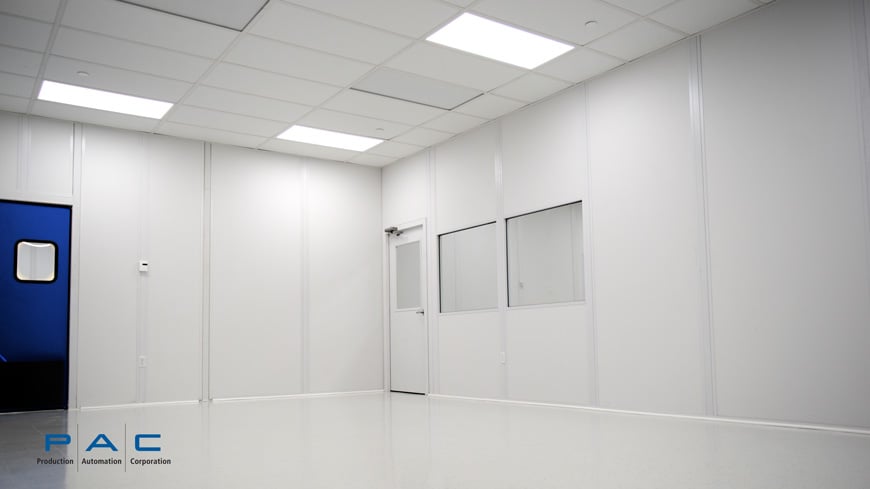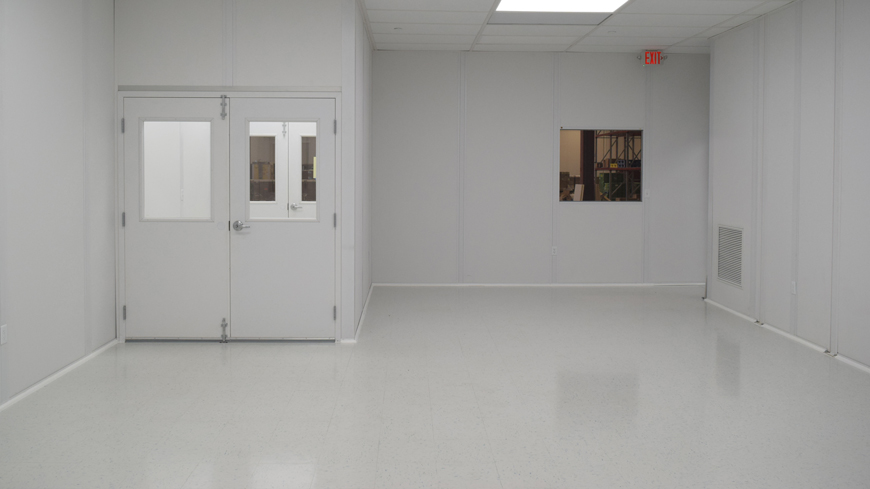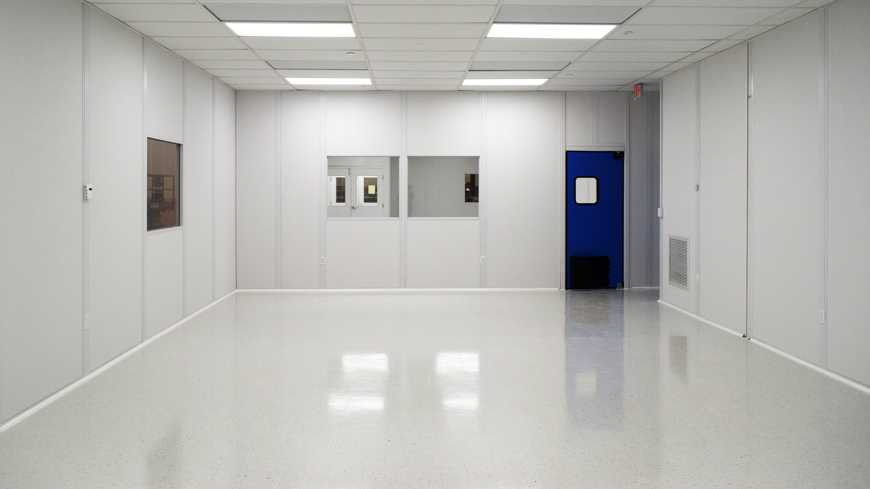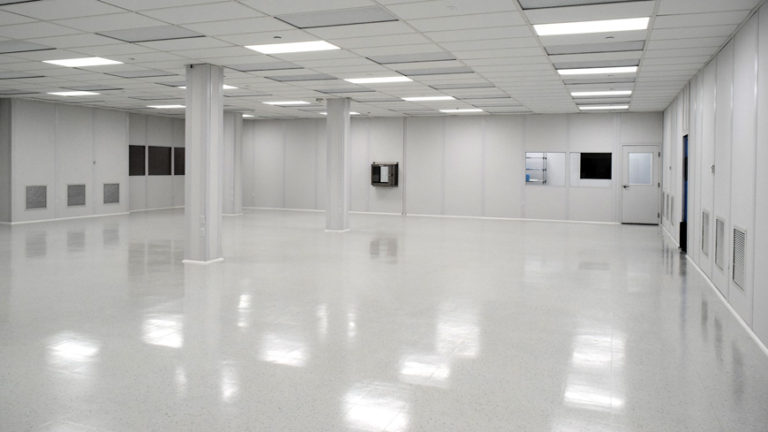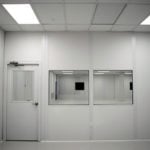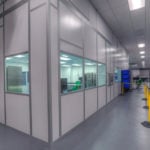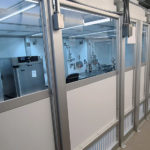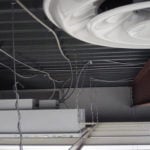Vinyl Composite Tile (VCT) is a durable flooring material for ISO 7 and ISO 8 cleanrooms. VCT’s reputation for easy cleaning, resilience, and durability is a well-received cleanroom flooring option, but also popular in healthcare facilities, government, and education.
There are a few final preparations required before the final cleanroom flooring installation.
Medical Device Cleanroom Build Guide
Part 1: Walls, Windows, & Containment
Part 2: Electrical, Mechanical & Partitions
Part 3: Fan Filter Units – Ceiling Grids
Part 4: VCT Cleanroom Flooring
Part 5: HVAC Design & Fan Filter Integration
Part 6: Pressure Differentials, Humidity and Temperature Calibration
Part 7: Cleanroom ISO Class Validation
Cleanroom Vinyl Compostive Flooring – VCT
VCT flooring is not to be confused with vinyl sheet flooring. VCT is a heavy-duty, industrial-grade material with rigid properties and great dimensional stability. It arrives as a 12′ x 12″ tile with a relatively flat surface finish. After installation, a topical wax and sealant preserve the material while also ensuring that grit or contamination is not harbored between the floor cracks.
VCT Sustainability – Chemical and UV Compatibility
NIST research (pg. 562) ranks VCT 20 – 30% higher in environmental performance and 90 – 170% higher in economic performance than linoleum or recycle ceramic tiles.
The material is stable to UV radiation and excess heat for use in a variety of industrial, laboratory, and cleanroom applications. Favorable rebound and compression prevent cracks and dents under a load of heavy equipment or impact of heavy objects. The natural look and refined finish are a nice accent to the finished cleanroom assembly.
Planning and Maintenance Considerations
The exact requirements of your cleanroom flooring and chemical cleaning requirements should always be discussed with your cleanroom designer. For a cleanroom flooring consultation at no cost, contact a PAC cleanroom specialist.
An 8,000 sq. ft. floorplan requires laser-guided placement for straight and accurate installation. The square cut tiles install similarly to any other type of flooring. A hand-operated floor cutter is all that’s required for cutting or shaping floor and trim pieces.
The benefit is an installation process that’s easily cleaned, cost-effective, and looks great. A 15 – 20 year operational life makes it a rather robust option. Historically, these materials are known to last up to 40 years.
Maintenance regularity is directly related to the volume of foot traffic, equipment use, and the degree of abrasive material deposits. VCT flooring in schools and hospitals may require additional sealant and buffing once or twice a year. This is not necessary for cleanroom scenarios.
The average school or hospital could see 100 – 1000x the traffic of the average cleanroom. Theoretically, a cleanroom’s original flooring seal could last a lifetime when properly cared for.
Cleanroom Flooring Installation
The concrete is first cleaned before applying a thin layer of adhesive to the sub-floor. The flooring is applied in 12″ by 12″ and then cut for edges, support columns, doorways, and drain fits as needed. Subsequently, a sealant patches any gaps or cracks and renders a glossy finish. Finally, trim is cut, placed and sealed where flooring and walls meet. The floor and sealant both require drying times, usually between 12 – 24 hours depending on climate.
After the initial install, deploying sticky mats at entrances will preserve the floor and prevent scuffs or staining by construction traffic. Outfit ladders with non-marring covers or soft cloth on the feet. Once cleaned, buffed, and sealed, those entering should don shoe covers to prevent scuffs and unnecessary debris into what is now a nearly immaculate cleanroom.
Another advantage of VCT is that it’s durable and economical enough for large, non-controlled parallel spaces. In this case, the space between the cleanroom and office spaces will also have VCT flooring.
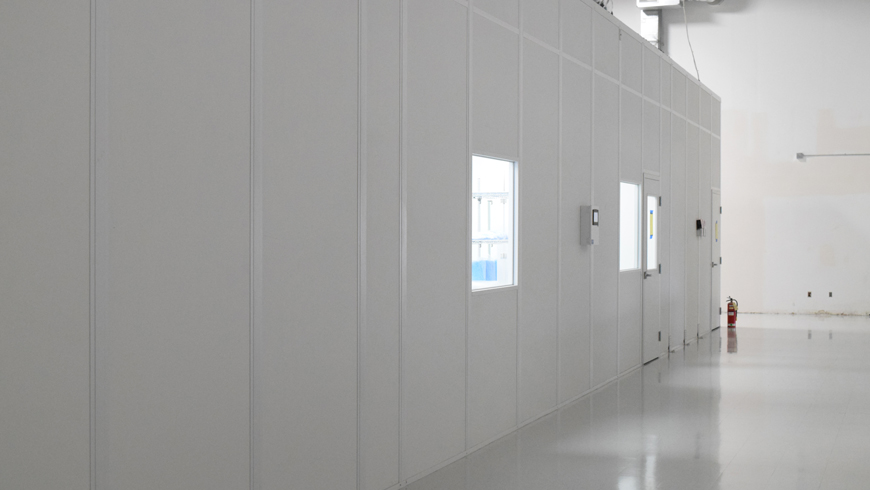
Different Considerations for Cleanroom Flooring
In the aforementioned case, the products are not electrically sensitive nor does the environment require sterile workflows. The assembly process at hand is relatively clean in nature, so a standard VCT tile flooring is a practical solution. Electronics-grade production environments require ESD flooring while pharmaceutical industries may opt for rubber or contamination control flooring.
Read: ESD for Lifesciences and Biotechnology Cleanrooms
PAC cleanroom specialists provide engineering, construction, outfitting, and environmental solutions for casual and critical production environments.
We’ve developed a culture of specialists that assess your needs and solve your manufacturing problems. Solving the right problem starts with asking the right expert. How can we help?
Related Posts
-
Medical Device Cleanroom Construction Part 2: Doors, Electrical, and Layout
In medical device cleanrooms, a common configuration is an ISO 8 gowning room and ISO 7 primary production area. A cascading air flow design and positive pressure HVAC calibration move the cleanest air at the…
-
Medical Device Cleanroom Classification
What Kind of Cleanroom Do I Need for a Class II Medical Device? What About Class III? This post classifies medical device cleanrooms for manufacturing and packaging.
-
Cleanroom Construction FAQ
Definitive Cleanroom Construction FAQ: How much does a cleanroom cost? How does the level of ISO classification impact build and operating costs? How much supporting space will I need for a cleanroom addition or ISO…
-
CleanPro® Turnkey Cleanroom Install
CleanPro’s turn-key cleanroom solution provided a one-stop, one-contact result for the initial delivery and on-site installation of walls, ceiling grids, electrical systems, flooring, filters, HVAC, and more.
-
CleanPro® Chemotherapy & CSP Cleanroom Installation
This modular, sterile compounding cleanroom is designed for USP 797 and USP 800 compliance, particularly for compounding chemotherapy drugs. Safe handling of sterile compounds requires special considerations: heat-welded floors, anterooms and buffer areas.
-
Medical Device Cleanroom Construction Part 2: Doors, Electrical, and Layout
In medical device cleanrooms, a common configuration is an ISO 8 gowning room and ISO 7 primary production area. A cascading air flow design and positive pressure HVAC calibration move the cleanest air at the…
-
Medical Device R&D Cleanroom with Insert-Style Construction
This unique ISO 5 cleanroom environment was built for specialized R&D within the medical device industry. This space was designed for the development of innovative eye care products. The semiconductor-style environment was required to achieve…
-
Medical Device Cleanroom Construction Part 1: Walls and Installation
How is a medical device cleanroom built? Here's a component-by-component guide to ISO Class 7 cleanroom construction.
-
Medical Device Cleanroom Construction Part 2: Doors, Electrical, and Layout
In medical device cleanrooms, a common configuration is an ISO 8 gowning room and ISO 7 primary production area. A cascading air flow design and positive pressure HVAC calibration move the cleanest air at the…
-
Medical Device Cleanroom Construction Part 3: Fan Filter Units - Ceiling Grids
In this post, we overview technical considerations for clean room fan filter unit selection, installation, and features. You'll learn how PAC approaches design and configuration of cleanroom HEPA filter units and fan filter housing specifications.…
-
Guide to Remote Particle Counters and Air Quality Monitoring Systems
Learn about the newest WIFI & IOT enabled air quality monitor features. Remotely monitor indoor & outdoor air quality including PM2.5 - PM10 particles, dust, C02, & VOCs.

